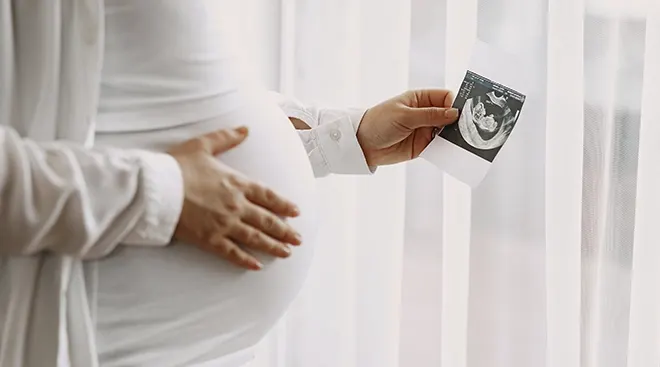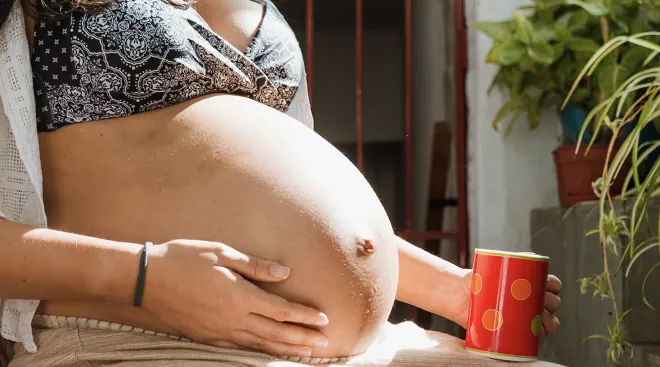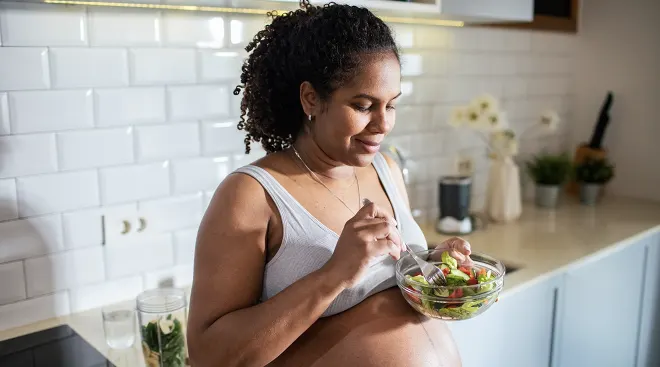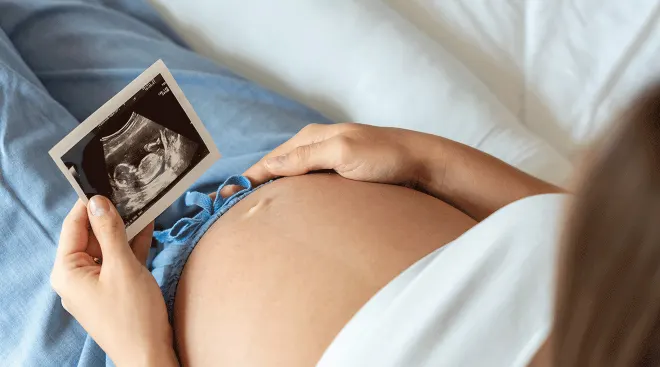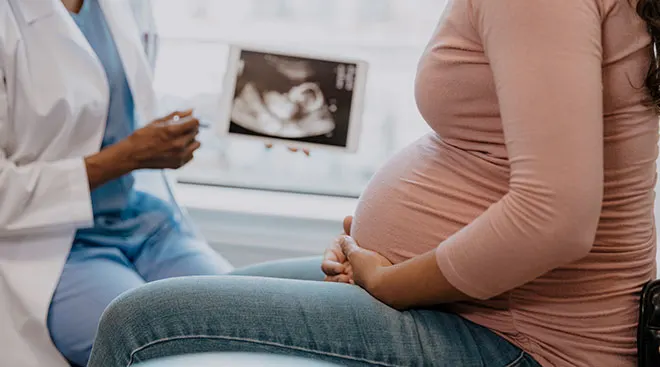How Do Babies Breathe in the Womb?
If you’ve recently had a pregnancy ultrasound, you might have seen baby’s chest rise and fall just like ours does as we breathe. This might make you wonder: Exactly how do babies breathe in the womb?
Since baby’s swimming in your amniotic fluid—and getting their oxygen from you—they’re not truly “breathing” the way we do, explains Tina Hendrick, MD, a board-certified ob-gyn and medical director at Pediatrix Medical Group in Elizabethtown, Kentucky. Rather, they’re practicing breathing. “This practice breathing shows us that babies are doing well inside the uterus, as those who aren’t won’t extend this extra effort,” she says.
Here’s what you need to know about fetal lung development, including when it starts, how it works—and how baby’s lungs prepare them for the major milestone of taking their very first breath.
Baby’s lungs begin forming soon after conception. Lung buds form first, followed by airways around 16 weeks and the production of surfactants—which keep the air sacs from collapsing—by 27 weeks, says Sherry Ross, MD, an ob-gyn and women’s health expert at Providence Saint John’s Health Center in Santa Monica, California, and author of She-ology and She-ology, the She-quel.
By 28 weeks, the lungs are mostly done developing, Ross says. And when baby’s 37 weeks, the lungs are fully developed and baby’s ready to take their first breath. “A growing baby receives oxygen through the umbilical cord, and not the lungs, until after delivery,” she notes.
Not in the traditional sense. Breathing is the process of exchanging oxygen and carbon dioxide in the lungs, says Ross. However, babies do have episodic, rhythmic diaphragm movements, says Melissa Bush, MD, an ob-gyn and medical director of Obstetrics and Perinatology & Maternal Fetal Medicine at MemorialCare Saddleback Medical Center in Laguna Hills, California. “Fetuses are living in a water-filled environment that we affectionately call a swimming pool of amniotic fluid,” she says. “Breathing movements recirculate this amniotic fluid inside the uterus.”
Why do these movements happen if baby isn’t actually breathing in air? According to Edgar Hernandez-Andrade, MD, PhD, professor and maternal-fetal medicine specialist with UTHealth Houston, the lungs expand and contract in utero because they’re:
- training the muscles responsible for baby’s breathing
- expelling the excess fluid produced during lung development
- helping the circulatory system move blood up from the lower parts of baby’s body
In other words, baby’s hard at work practicing their breathing!
The rhythmic movements of baby’s diaphragm that help them practice breathing start at around 11 weeks gestation, says Hernandez-Andrade. “The frequency and intensity of breathing movements increase throughout gestation,” he adds.
These movements are often unpredictable. Between 24 and 28 weeks, baby’s usually practicing breathing about 10 to 20 percent of the time, which increases to around 30 percent at 30 weeks of gestation, research says.
Baby’s breathing is strongly connected to movement in the womb, says Hernandez-Andrade. “When Mom feels fetal body movements, she’s reassured that breathing movements are also present,” he says.
Baby relies on your placenta to supply them with the oxygen they need to survive. “While in the womb, the amazing organ called the placenta accomplishes the function of all our human body systems including [oxygen and carbon dioxide] exchange,” says Bush. “The umbilical cord brings blood and nutrients from the mother to the baby.”
When baby takes their first breath, the lungs inflate with air as the amniotic fluid is pushed out, explains Ross. “Once air and oxygen enter the lungs at birth, the normal breathing process begins,” she says.
According to the National Library of Medicine, baby takes their first breath within about 10 seconds after delivery: “This breath sounds like a gasp, as the newborn’s central nervous system reacts to the sudden change in temperature and environment.”
Frequently Asked Questions
Does baby breathe through their mouth or nose in the womb?
Neither. Again, baby doesn’t “breathe” in the womb the way we do in the outside world, says Hendrick. Instead, they receive oxygen from the umbilical cord, which is attached to Mom’s placenta. Any “breathing” you may see on an ultrasound is baby’s diaphragm expanding and contracting as they practice for the real deal, says Ross.
Does baby cry in the womb?
Hendrick says there’s evidence that babies do cry in the womb. While you can’t see any tears or hear sound, she says grimacing, chin quivering and open mouths can all be observed on ultrasound.
How can lung development be medically supported?
If you’ve been told you’re at risk for preterm labor—or you go into it unexpectedly—there are many ways healthcare providers can support baby’s lungs until they’re mature enough to function on their own. Which method is best for baby, though, depends on how many weeks gestation they are at birth, how much trouble they’re having breathing and their overall health, says Cedars-Sinai. These methods include:
- Corticosteroids given before delivery, typically between 24 and 34 weeks, to lower the risk and severity of respiratory distress syndrome (RDS), a common issue in premature babies
- Supplemental oxygen delivered through a nasal tube (cannula) to improve airflow
- A surfactant medicine delivered through a tube from the mouth into the lungs, which also helps keep them open
- A ventilator, which mechanically “breathes” for baby, bringing oxygen into their lungs
- A continuous positive airway pressure (CPAP) machine that works like a ventilator but is less invasive
Hendrick says that, with time and the right care, baby’s lungs should grow and eventually be strong enough to breathe independently.
Surrounded by amniotic fluid, babies don’t actually breathe in the womb; they get all the oxygen they need from Mom. But their lungs do practice breathing in utero, expanding and contracting in a rhythmic movement that strengthens their respiratory muscles and provides a few other benefits for their developing bodies. This is important work, because as soon as baby’s born, their lungs need to make the transition from receiving oxygen through the placenta to filling with air and exchanging oxygen and carbon dioxide (i.e. breathing!) on their own.
Please note: The Bump and the materials and information it contains are not intended to, and do not constitute, medical or other health advice or diagnosis and should not be used as such. You should always consult with a qualified physician or health professional about your specific circumstances.
Plus, more from The Bump:
Melissa Bush, MD, is an ob-gyn and medical director of Obstetrics and Perinatology & Maternal Fetal Medicine at MemorialCare Saddleback Medical Center in Laguna Hills, California. She received her medical degree from Harvard University Medical School.
Tina Hendrick, MD, is a board-certified ob-gyn and medical director at Pediatrix Medical Group in Elizabethtown, Kentucky. She received her medical degree from the University of Louisville School of Medicine.
Edgar Hernandez-Andrade, MD, PhD, is a professor and maternal-fetal medicine specialist with UTHealth Houston. He received his medical degree from the School of Medicine of the National Polytechnic Institute in Mexico City.
Sherry Ross, MD, is an ob-gyn and women’s health expert at Providence Saint John’s Health Center in Santa Monica, California. She’s the author of She-ology: The Definitive Guide to Women’s Intimate Health. Period. and She-ology, the She-quel: Let's Continue the Conversation. She received her medical degree from New York Medical College.
Radiopaedia, Fetal Breathing Movements, September 2023
MedlinePlus (National Library of Medicine), Changes in the Newborn at Birth, November 2023
Cedars-Sinai, Respiratory Distress Syndrome (RDS) in Premature Babies
Learn how we ensure the accuracy of our content through our editorial and medical review process.
Navigate forward to interact with the calendar and select a date. Press the question mark key to get the keyboard shortcuts for changing dates.










































